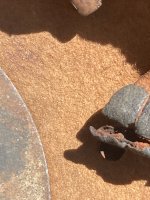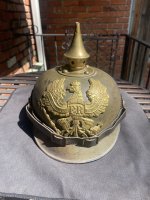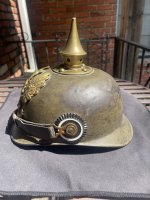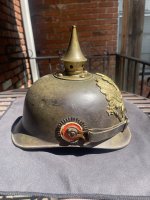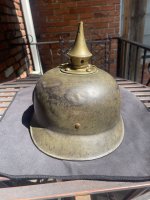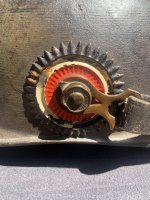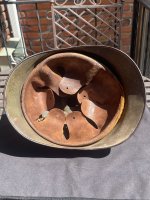You are using an out of date browser. It may not display this or other websites correctly.
You should upgrade or use an alternative browser.
You should upgrade or use an alternative browser.
My Ersatz collection
- Thread starter Andy be Prussian
- Start date
Andy be Prussian
Well-known member
My next ersatz pickelhaube I will post was a case of mistaken identity on my end. Initially, I assumed this to be a paper ersatz Saxon haube. Upon closer inspection and what I could find in references, I believe this is instead a shellacked felt model, with the felt being in an orange color. I think there’s a post somewhere here about a similar Bavarian model, with the gray felt.
The shellac itself has an interesting look to it. What seemed to have happened is this pickelhaube was left in a hot climate somewhere, and the shellac bubbles due to the heat, resulting in what you see in the pictures.
Any info on these style of ersatz helmets is welcomed!
The shellac itself has an interesting look to it. What seemed to have happened is this pickelhaube was left in a hot climate somewhere, and the shellac bubbles due to the heat, resulting in what you see in the pictures.
Any info on these style of ersatz helmets is welcomed!
Last edited:
John Josef
Well-known member
What very interesting patterns to the visor and shell I don't think I've ever seen a helm with so many different textures on the same helmet.
Sure, tells a story
Sure, tells a story
Tins&Blades
Active member
Welcome to the forum and thank you for sharing such an amazing Ersatz collection!
Like you, I too really enjoy the Ersatz pickelhauben. Something about the variety and the scramble to find resources to make them for the war effort just captivates my attention.
I find myself continuously learning from the wonderful collections shared here. Thanks again.
Cheers,
-Alex
Like you, I too really enjoy the Ersatz pickelhauben. Something about the variety and the scramble to find resources to make them for the war effort just captivates my attention.
I find myself continuously learning from the wonderful collections shared here. Thanks again.
Cheers,
-Alex
CLOVIS 57
Well-known member
Here's my BING in pressed, varnished, black cardboard. We know the sheet metal BING, but the cardboard one is much rarer. BING trim details are the same for cardboard and sheet metal. (tip base 2mm higher, rivet lugs and front plate longer and rounded at the end.




The “Teller” is stamped BING Nürnberg. Tellers marked with the maker's name are very rare; I know of only one other “Karl Goldschmidt 1914 Luckenwalde”, also from Bavaria. Goldschmidt is dated 1914 and Bing is dated 1915.
Goldschmidt is dated 1914 and Bing is dated 1915.

Unique in an Enlisted WW1 spiked helmet, (except Late War Officer) the perforations in the inner cap.
 A unique feature of this helmet: the steel-gray is gilded or copper-plated, and is removed from the tip, but remains on the faceplate, chinstrap and even the rivet lugs, none with gilding.
A unique feature of this helmet: the steel-gray is gilded or copper-plated, and is removed from the tip, but remains on the faceplate, chinstrap and even the rivet lugs, none with gilding.




The “Teller” is stamped BING Nürnberg. Tellers marked with the maker's name are very rare; I know of only one other “Karl Goldschmidt 1914 Luckenwalde”, also from Bavaria.
 Goldschmidt is dated 1914 and Bing is dated 1915.
Goldschmidt is dated 1914 and Bing is dated 1915.
Unique in an Enlisted WW1 spiked helmet, (except Late War Officer) the perforations in the inner cap.
 A unique feature of this helmet: the steel-gray is gilded or copper-plated, and is removed from the tip, but remains on the faceplate, chinstrap and even the rivet lugs, none with gilding.
A unique feature of this helmet: the steel-gray is gilded or copper-plated, and is removed from the tip, but remains on the faceplate, chinstrap and even the rivet lugs, none with gilding.Andy be Prussian
Well-known member
I absolutely love the his one. Paper/Cardboard ersatz are my favorite ones to collect. I’m very fascinated that Bing made other ersatz variants.Here's my BING in pressed, varnished, black cardboard. We know the sheet metal BING, but the cardboard one is much rarer. BING trim details are the same for cardboard and sheet metal. (tip base 2mm higher, rivet lugs and front plate longer and rounded at the end.
View attachment 51879
View attachment 51880View attachment 51882 View attachment 51883
The “Teller” is stamped BING Nürnberg. Tellers marked with the maker's name are very rare; I know of only one other “Karl Goldschmidt 1914 Luckenwalde”, also from Bavaria. View attachment 51888 Goldschmidt is dated 1914 and Bing is dated 1915.
View attachment 51884
Unique in an Enlisted WW1 spiked helmet, (except Late War Officer) the perforations in the inner cap.
View attachment 51887 A unique feature of this helmet: the steel-gray is gilded or copper-plated, and is removed from the tip, but remains on the faceplate, chinstrap and even the rivet lugs, none with gilding.
Andy be Prussian
Well-known member
John Josef
Well-known member
My next ersatz need no other introduction. My own Bing made, tin pickelhaube. Since there are a few good threads about Bing and its ersatz variants, I won’t add anything that isn’t already known. Just a nice, solid ersatz haube
Nice example congratulations, I really love these helmets just such an interesting time in helmet production.
Andy be Prussian
Well-known member
Andy be Prussian
Well-known member
Andy be Prussian
Well-known member




A look underneath the pickelhaube. The liner is in pretty good shape with its leather drawstring still attached. The liner has a very faint stamp of 56, which is corroborated with another 56 stamp outside the pickelhaube, covered by the spike base. Notice that the prongs from the fasteners are secured on with the addition of washers, rather than the usual metal disc
Andy be Prussian
Well-known member
Andy be Prussian
Well-known member







My only felt haube in my collection so far. This Baden one is about as simple as they come by. Whats interesting about this one is something has happened or has been applied to the leather where it has completely stiffened the whole chinstrap. This chinstrap is not going anywhere. The state cockade has completely lost its paint and probably will stay that way. Note it retains its original drawstring
Very nice helmet, congratulations 
Regards,
Lars
There has been a period where collectors used a lot of "care" products on their leather collectables, softening the leather short-term, but hardening and warping it long-term. At least your chinstrap looks very natural and not warped.something has happened or has been applied to the leather where it has completely stiffened the whole chinstrap.
Regards,
Lars
brusik1
Well-known member
Hello, maybe someone can tell me what material the Ersatz Pickelhaube is made of? Compressed wood chips?
Attachments
Andy be Prussian
Well-known member
You have there a paper/cardboard ersatz pickelhuabe. It is paper and/or cardboard that’s been mixed with glue into a pulp, then shaped and painted over into a haube. They are my favorite ones to collect and I intend to make a separate thread about them soon. Here’s one example I own:Hello, maybe someone can tell me what material the Ersatz Pickelhaube is made of? Compressed wood chips?










